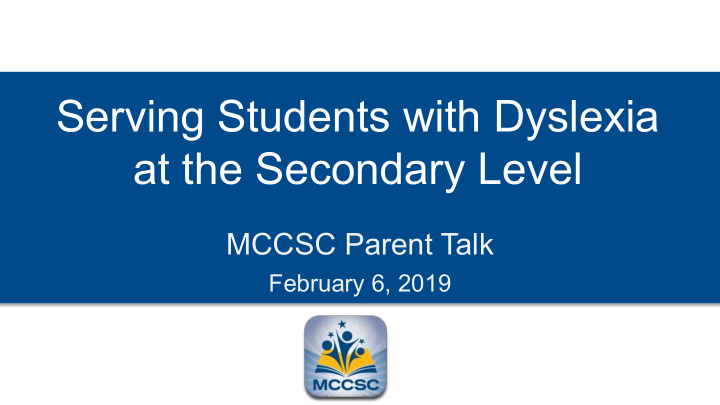



Serving Students with Dyslexia at the Secondary Level MCCSC Parent Talk February 6, 2019
Tonight’s Agenda ➢ Supporting former Pinnacle students in MCCSC ➢ Describe Dyslexia at the secondary level ➢ MCCSC supports at the secondary level ○ Framework for literacy instruction/intervention ○ Classroom examples from teachers ○ Accommodations & Assistive Technology ○ Transition Planning ➢ Q & A
Supporting Former Pinnacle Students • Pinnacle Closing (2015-2016): • 48 students transferred to MCCSC: • 7 have graduated • 9 moved out of district, 2 are home-schooled • Teacher Training & Ongoing Supports: • 161 teachers trained in Orton Gillingham program with additional training scheduled for this summer. Dyslexia training since 2008. • Ongoing support with teachers & parents re student’s needs • Currently 30 Students: • High School: 13 students (7 are seniors) • Middle School: 12 students • Elementary: 5 students
Dyslexia Defined (International Dyslexia Association 2017) “A Specific Learning Disability that is neurobiological in origin. It is characterized by difficulties with accurate or fluent word recognition and by poor spelling and decoding abilities. These difficulties result from a deficit in the phonological component of language that is often unexpected in relation to other cognitive abilities and the provision of effective classroom instruction.” In other words… Unexpected difficulty learning to read despite intelligence, motivation, and appropriate education.
The Focus of Reading Instruction for Adolescent Readers Instructional recommendations organized into five general areas: • Word study, fluency, vocabulary, comprehension, and motivation. • Instruction in advanced word study, or decoding multisyllabic words Less emphasis on: • Phonemic awareness and phonics, which many older readers have accomplished. Of course, we recognize that older readers possess a range of knowledge and skills, and there may be older readers who would profit from instruction in the more foundational skills Effective Instruction for Adolescent Struggling Readers: A practice brief. Center on Instruction
Dyslexia in Adolescents • An avoidance of reading for pleasure and of reading aloud. • Difficulty with note taking in lecture-based classes. • A tendency to struggle to retrieve words. • A self-image of being dumb, or a concern that the students’ peers think he is dumb despite good grades. • Difficulty with multiple-choice tests. • Extreme fatigue when reading • Difficulty with organizing projects and time management. • California Dyslexia Guidelines 2017
A Student’s Perspective
Secondary Students • Students are working toward high school graduation • Students are entrusted with more responsibility • Students are becoming more self-aware and better self-advocates • Post-high school outcomes more of a focus
https://www.doe.in.gov/literacy/dyslexia
Evidence-based
MCCSC Secondary Literacy Continuum Core Instruction = grade-level standards-based instruction provided to all Strategic Instruction = explicit instruction and/or guided practices in targeted key areas Intensive Intervention = instruction for students with significant core reading deficits
Evidence-based instructional strategies: ● Graphic organizers (visual representations of information) ● Reading guides (questions, look-fors in text, definitions, etc.) ● Guided notes (provide notes where student fills in key content) ● Pre-teaching (providing access to content before whole class instruction) ● Student efficacy (conversations with students about their progress & needs) ● Hands-on, multisensory experiences for content ● Verbal and written instructions ● Chunking material
District-wide Standards: ● Guaranteed minimum of 40 minutes within the instructional day ● In addition to core instruction ● Intervention and/or enrichment ● Teacher assigned ● Targeted to individual student need ● Guided by academic performance
District-wide Standards: ● Intense, rigorous intervention ● In addition to Core and Strategic Instruction ● Class scheduled for intervention ● Programming that is systematic, sequential, and cumulative ● Consideration for the 5 components of literacy (phonemic awareness, phonics, vocabulary, fluency, comprehension) based upon student need
Accommodations • Classroom • ILearn and ISTEP+ • PSAT/SAT/AP • Hoosier Hills Career Center State Certifications
Assistive Technology • School Device - speech to text, spell check and editing tools, screen or font enlargement • YouTube - audio combined with text that scrolls • Editing checklists • Online books • Predictive text • Google Suite - Docs, Slides, Sheets, etc... • https://www.opendyslexic.org/
Preparing Today for Life after High School Transition Planning starts at age 14: • Developing self-advocacy skills • Preparing for College: – Supports in college (disability office) – College entrance tests (PSAT/SAT/ACT) accommodations • Preparing for Workforce: HHCC, Work Study • Other: accommodations on BMV written driving test
Who Do I Contact? Or email us at: reading4all@mccsc.edu
Recommend
More recommend